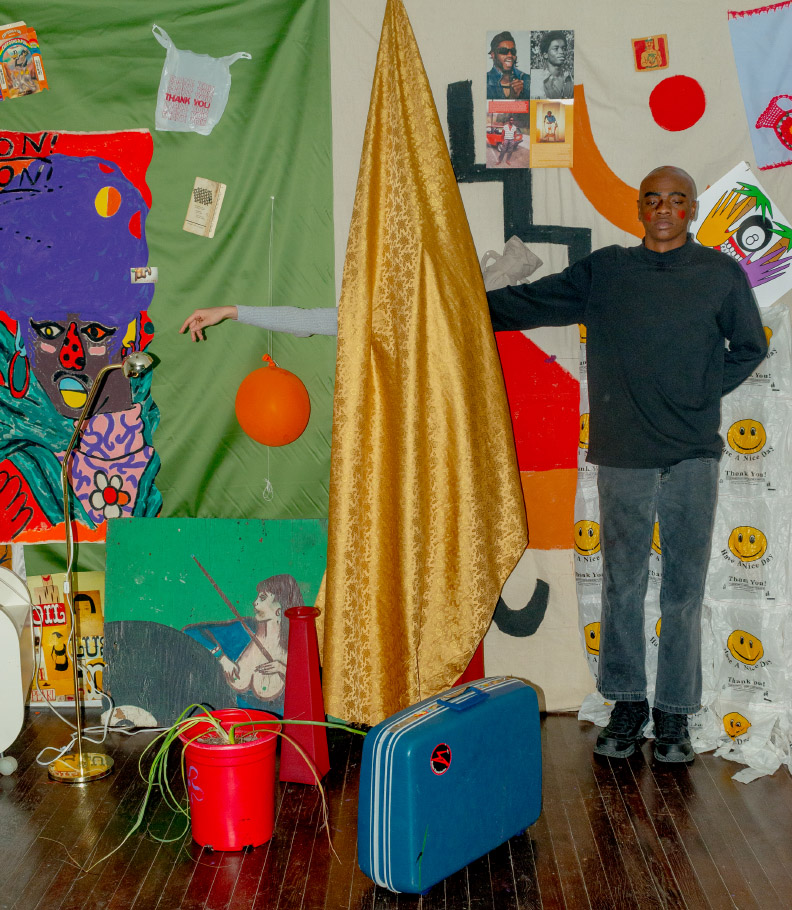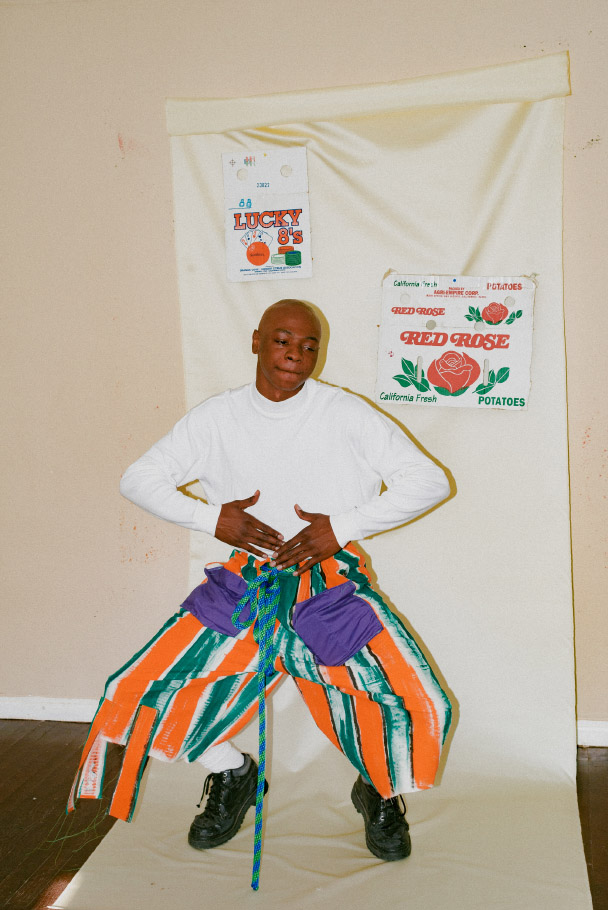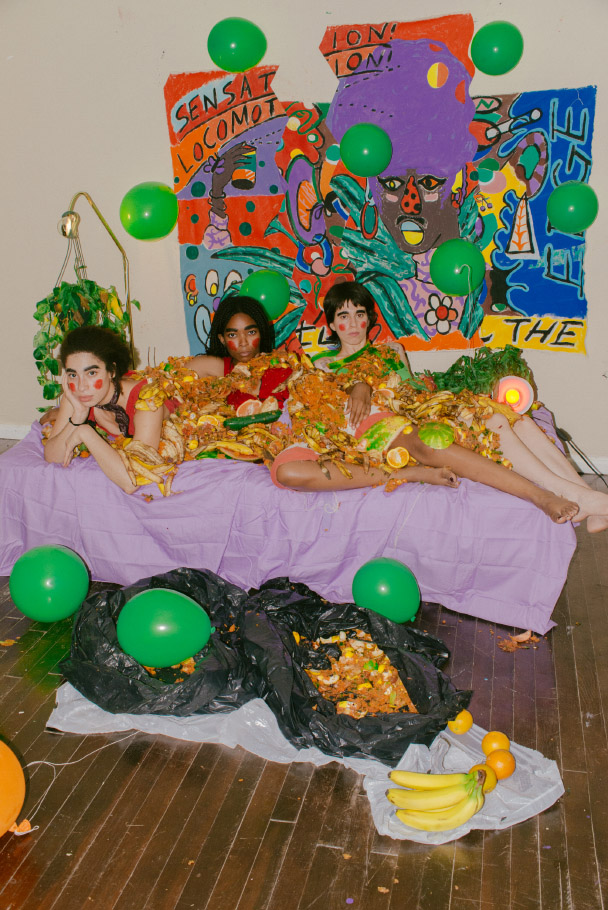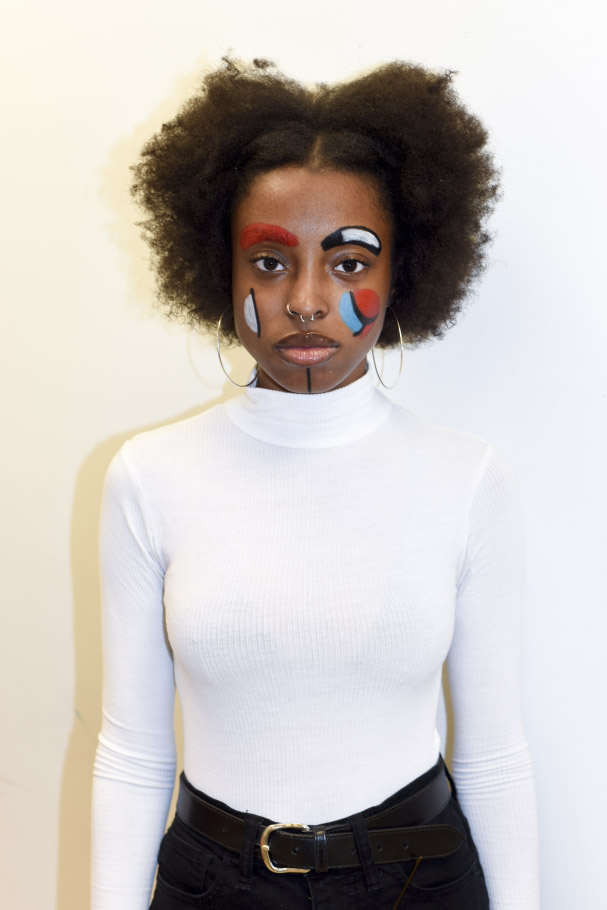B. Anele
Making garments that challenge the boundaries between clothing, art and gender, B. Anele is a 25-year-old trans-disciplinary and gender nonconforming artist from in Houston, Texas, who recently moved to Los Angeles, California. Ranging from raw-canvas sculptural garments and portraiture to soft sculpture, B. Anele’s pieces transcend into architectural forms; from conjoined jackets with arms that extend into a monumental, unifying chain to a jumpsuit with tar-colored, ten-foot-long pant legs intersected by broken, white road lines, these works commune with space and act as elements that support and restrict the human figure. What results is a breadth of colorful commentary on the reciprocal relationship between clothing wearers and their surroundings, and the ways in which fashion allows us to perform our identities.
Embellished with vibrant, gestural strokes, fruits, and counter-cultural icons such as smiley faces from club culture or retro roller skates, which have enjoyed a renaissance in the queer community, B. Anele’s work challenges the traditional boundaries of fashion design today. Each of their objects is imbued with a sense of spiritualism as the artist makes a point to meditate over each design, honoring indigenous art garments that once were intended for sacred purposes while also bringing some of the specialness back to clothing items and style as a whole.
For B.Anele, garments are both a form of creative expression and social activism against harmful gender confines. While the scale of the garments and the intensity of the imagery may appear provocative or stir an emotional response in viewers, the pieces remain relatable and ignite a sense of playful curiosity in all those who witness them.
In this interview, I speak to the artist about their creative practice and their recent show, B.Anele: I Don’t Play That Game, which opened on July 27 and will be up until October 7 at the Houston Center for Contemporary Craft.
When did you first start making wearable art? What is it about wearables that interests you most?
I first started making wearable art objects in the spring of 2016. I enjoy working with clothing because I like the idea of breaking the barriers between the concept of art being something you do not touch. Creating wearables means taking the artwork out of the gallery or museum and allowing it to exist within the context of everyday life. I like the idea that I can become a part of someone else’s expression. I also feel there is a certain power within garments – I meditate over all of my garment designs. I think about indigenous art garments intended for sacred purpose s- I like to think of my pieces in a similar way. I believe art is a very very important element in the road to a better future- more people need to b introduced to an artistic perspective to life.
What inspired you to create the body of work currently on display?
Whenever I have an exhibition it is always curated work from my ever growing body of work. I don’t create separate bodies of work – it is all just one large evolving body of work.
Tell us more about the fashion show. What was your aim with it? Who modeled?
My fashion shows are an extension of my permanent focus of titillating the minds of my peers, pushing the boundaries of their minds while maintaining a purposeful aesthetic. All my handsome friends are always my models- some queer, some gay, some poc, nb, artists, etc
In what ways do you believe fashion today is not inclusive or accessible enough?
I feel that the fashion world even though it is growing more than ever within its inclusivity could still use a lot more work within promoting the idea of beauty being something that can be found in any type of body. The fashion world needs to stop creating a box of what beauty supposedly looks like because the effect reaches deeper than just the fashion world - this toxic mindset trickles down into the general public as well.
How do you attempt to “weave a provocative and indisputably familiar blanket for the viewer to be engulfed in"?
My work is intended to evoke emotions, thoughts and ideals within the viewer but in a way that makes them feel comfortable doing so. Like being lead through a new doorway confidently because you are hand in hand with someone who would not allow you to get hurt on the other side.
How do you see your artwork as a form of social activism? Are you aiming to use fashion as a way to talk about social justice issues such as gender, sexuality and race?
I see my work as a form of social activism because my work ventures into crevices which are not frequently explored - I feel that I am creating a space for the outsiders like myself to thrive within. Even within my choice of models - I work with a wide variety of body types and I never discriminate. And for anyone who knows about art history up until this point - for me to be a queer POC within the art world in itself is a political act and I hope to create room for more people like myself in these types of spaces.
What do you hope viewers will take away from seeing this body of work?
I hope that people will approach the work with an uninhibited mind and without prior concepts of what art has to be - I hope people will take away the energy of possibility, a heightened appreciation for and awareness of the power of expression.
You just moved from Houston to Los Angeles. What are you most looking forward to in your new city?
I am excited to be surrounded by a larger amount of opportunity to work with people like me. There is an insanely abundant amount of young and old creative energy flowing through Los Angeles - I can feel it all around me. I'm also just excited to be within a new scenery - I am very easily affected by my environment and I am aroused by the topography of this city in particular.
courtesy B. ANELE
interview SARA RADIN
What to read next















